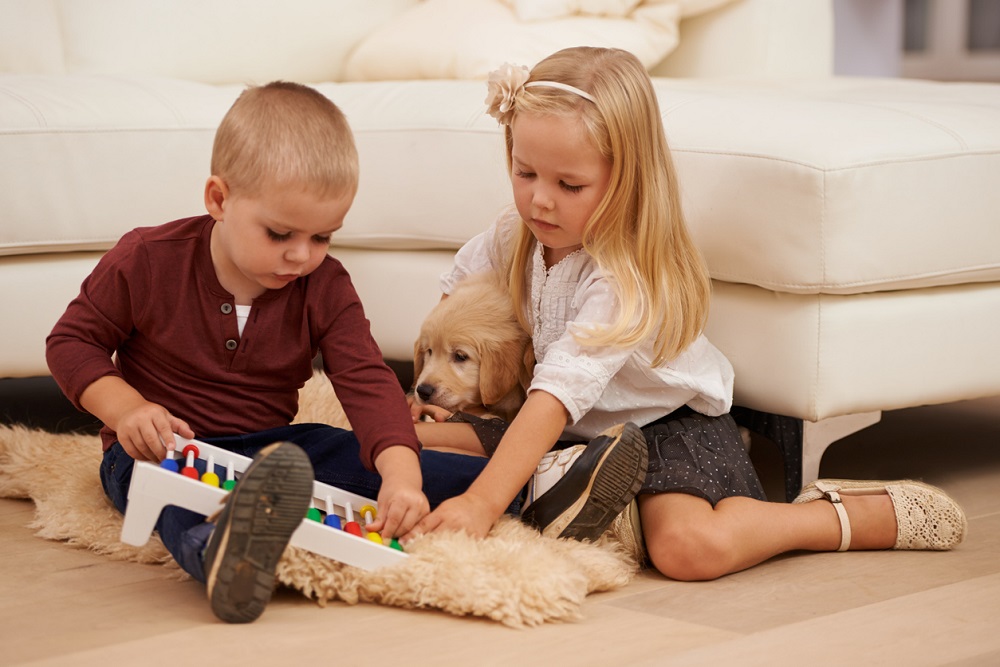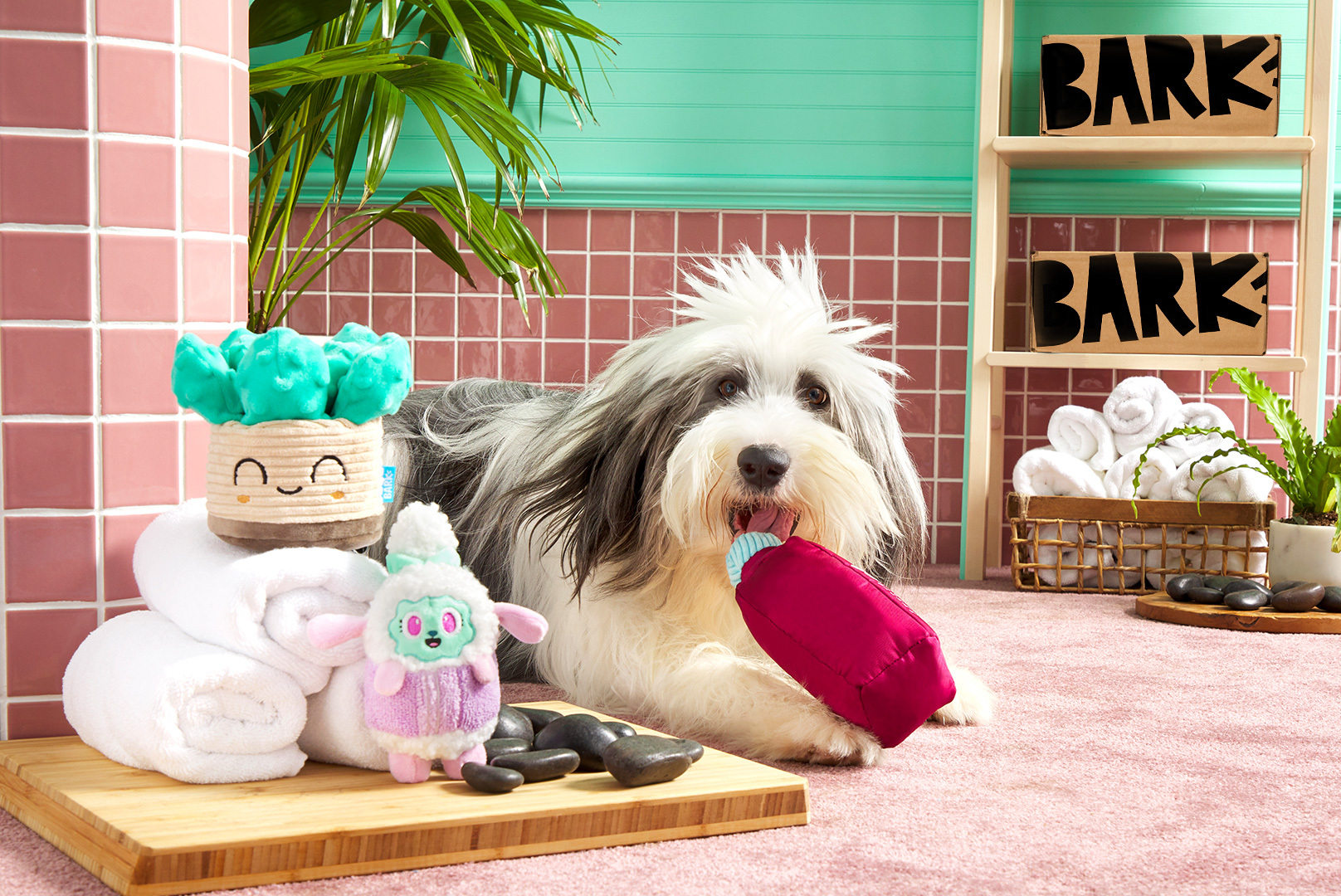For Pups With Short Attention Spans…
Despite their perceived dopiness, Labrador retrievers are one of the smartest dog breeds, which is one reason they are one of the most popular dog breeds in America. Labs have strong instinctive intelligence and adaptive intelligence and are noted for their trainability and work ethic, the perfect dog for families and those new to dog ownership.
Weekend park play sessions, nightly cuddle puddles—life with labs is anything but ruff. This beloved breed is uber-friendly, ultra-energetic, and one of the smartest dog breeds.1
While a Labrador retriever certainly can’t do multivariable calculus, they’re exceptionally obedient and are highly regarded as working and guide dogs.
But really, are labs smart? Put on your goggles and white coat, we’re bringing labs to the lab to introduce seven tests to measure your dog’s intelligence and four simple ways you can nurture your pup’s cognitive ability and overall health.
How To Measure Your Lab’s Intelligence
While measures of animal intelligence have traditionally focused on rodents and monkeys, dogs are increasingly popular subjects, especially within the last two decades.2
In 2004, a border collie named Rico wowed researchers with his 200-word vocabulary and ability to learn the name of an object in one try. Since then, interest in dog intelligence and language-processing abilities has only grown.3
Ask any scientist who studies intelligence, and they’d explain that the concept actually encompasses multiple different types of intelligence. For humans, this is obvious. Think about yourself. Maybe you struggled in AP English but kicked some serious AP Calculus butt. Or the other way around—maybe you’re all about logic and math but struggled to write your essay on The Great Gatsby. No surprises here that dogs are the same.
While you won’t find your lab nose-deep in a Fitzgerald novel, we can break down dog intelligence into two key areas:4
- Instinctive Intelligence – Dog breed and type decide a pup’s instinctive intelligence. Dogs have been bred over many centuries for specific abilities. As a result, a beagle would probably do better solving a scent-specific cognitive test while a greyhound would perform better on a sight-specific cognitive test.
- Adaptive Intelligence – The other kind of intelligence comes down to individual dogs’ learning ability. This ability includes everything from language comprehension and task learning to environmental and social learning. Just like you might have been great at AP English and not AP Calculus, your smart lab can be fantastic at learning tasks but not at learning language cues.
Researcher and psychologist Dr. Stanley Coren from the University of British Columbia believes that dogs are as intelligent as human toddlers (children between 2 and 2.5 years specifically).5 That said, he identified dogs’ incredible intelligence across multiple mediums, including:5
- Numbers – Certain smart dogs can count up to four or five and notice basic computational errors (i.e. 1+1=1 rather than 1+1=2).
- Language – The average dog can learn 165 words and signals. Dogs in the top twentieth percent of intelligence like the famous Rico can learn up to 250 words. They can even understand the meaning of symbolic concepts.
- Spatial Awareness – Dogs learn and remember different routes in their environment, how to operate simple mechanisms like door handles, and where you keep things they like, such as treats.
- Deception – Dogs can even lie (kind of). Dogs can trick both humans and other dogs. Usually, this is reward-seeking behavior (think treats).
As with dog behavior, a lot of wisdom into the intelligence of different dog breeds is inherited by word of mouth. However, 208 dog obedience judges from the United States and Canada did rank popular breeds based on intelligence.
They found that the top seven most intelligent breeds are the:5
- Border collie
- Poodles
- German shepherd
- Golden retriever
- Dobermans
- Shetland sheepdogs
- Labrador retriever
Seventh place ain’t too bad; chocolate lab, yellow lab, and black lab owners rejoice!
Still, breed certainly isn’t the only defining characteristic when it comes to a dog’s intelligence. A 2016 study by British psychologists on 68 border collies highlighted how much intelligence can vary within breeds. The study defined the canine “g” factor as a general factor of intelligence in dogs.
To identify this factor, they performed three cognitive ability tests, including:6
- Detour Test – In this test, the dogs had to maneuver around different obstacles and dog puzzles to obtain a treat, like our Beef Liver Crunchies.
- Point-following Test – In this test, researchers pointed at one of two beakers with a hidden treat and recorded whether the dogs went to the one they pointed to.
- Quantity Discrimination Test – In this test, the dogs had to choose between two different treats based on size, with the bigger treat being the correct choice.
All 68 dogs were, of course, the same breed, but they also had similar backgrounds and upbringings because they were all trained for herding work on farms. Despite these genetic and environmental similarities, their scores on the cognitive tests differed. For the detour test, the fastest dog completed the task in just three seconds while the slowest completed the task in almost two minutes.6
Additionally, dogs who performed well on one test were more likely to perform well on the other two. That’s where the canine “g” factor comes in.6
On an extremely simplified level, think of it like the concept of human IQ, one quantitative measure to encompass overall canine intelligence.
Learn about thirteen of the smartest dog breeds here.


DIY Dog IQ Test
But you probably don’t really care how smart Rico or 68 border collies are. As a dog owner, you want to know how smart your family dog is. Indeed, it’s time for a proper doggy IQ test for your own pup.
Here are seven that you can easily complete at home:
- The Cup Test – Create your very own magic show for your dog. With your dog watching, put four cups in a row upside down. Place a treat under one cup and then slide the cups around slowly to change their order. Then, see if your dog can correctly identify the cup the treat is under.7 You can also try this test using buckets and your dog’s favorite toy.4
- The Towel Test – Turn your pup into Houdini. Gently place a towel over their head and see how long it takes them to get out from under it. Of course, only do this if your dog is comfortable.7
- The Treat Test – Take a treat and show it to your dog. Then close both hands and see if your dog can identify which hand the treat is in. If they choose wrong, show them the empty hand. If they’re super smart, you can even switch the treat between hands.7
- The Furniture Test – Put your dog in another room and then rearrange the furniture. When you let your dog back in, they should ideally go straight to their favorite spot, despite all of the changes.4
- The Reach Test – Place a treat somewhere your dog can’t easily get to, like under a low-hanging chair or table. Then, see how long it takes them to pull it out with just their paws.4
- The Walk Test – At an odd time of the day, pick up your dog’s leash and head towards the door. They should pick up your cues and get excited for a walk, even though it’s not at the usual time of the day.4
- The Barrier Test – Create a barrier and put something your dog loves like a favorite toy or treats on the other side. See how long it takes them to go around the barrier and what route they use to do so.4
All seven of these tests can also be novel ways to keep your dog mentally stimulated and engaged. Learn more about how to give your dog an IQ test here.


4 Ways to Keep Your Lab’s Brain Healthy
Keeping your dog engaged is always important but especially so as they age. Cognitive abilities naturally decline with age, including measures like:8
- Eye contact
- Short-term memory
As a pup parent, you no doubt want to keep your pup happy and healthy, regardless of their age. Four ways to protect your pup’s cognitive abilities include:8
- Physical Exercise – Regular activity and agility sports are important to your dog’s overall health, which impacts their cognitive ability. It also keeps them mentally stimulated,engaged, and prevents a host of Labrador retriever health issues.
- Training – Keep your dog engaged no matter their age by continuing to train new skills. This will also help strengthen your bond with your dog. You can even teach your dog new words by naming new toys whenever you get them.
- Good Nutrition – Research suggests that nutrition plays a role in how dogs’ cognitive ability changes with age. In particular, aging dogs have a decreased ability to use glucose for energy, so foods with medium chain triglycerides (MCTs) can be an excellent alternative energy source. Learn how to switch your dog’s diet the right way here.
- Playtime – Playing with your dog is another way to keep them mentally stimulated. You can go above and beyond with games like hide and seek. Hide your dog’s favorite toy and help them search for it or divide up their dinner and put it in different places throughout the house.
Each of these four methods promotes both mental and physical health for your dog.


Kibble to BARK About
So are labs smart? Most definitely. In fact, by one measure, they’re the seventh smartest dog breed. (Now, off to the dog park for a victory lap!)
While dogs’ intelligence varies based on their breed, environment, and the individual dog itself, there’s a lot you can do to promote your pup’s cognitive abilities.
From regular training sessions and playtime to exercise and good nutrition, there’s no shortage of ways to take care of your fur baby. But of course, that means it can also become overwhelming to make the right choice for your dog.
With BARK, you get high-quality, Labrador dog food to promote your pup’s wellness, mind, and body. Our food is designed specifically with labs’ health needs in mind. We even have a Pivot Puzzle Toy to keep your lab engaged and interested in treat-time.
Different breeds have different needs. Discover your lab’s today.
Sources:
- American Kennel Club. Labrador Retriever. https://www.akc.org/dog-breeds/labrador-retriever/
- Vox. Why scientists believe dogs are smarter than we give them credit for. https://www.vox.com/2015/4/7/8360143/dogs-intelligence-science
- The Atlantic. What Animals Teach Us About Measuring Intelligence. https://www.theatlantic.com/education/archive/2015/02/what-animals-teach-us-about-measuring-intelligence/386330/
- Today. How smart is your dog? Give him an IQ test. https://www.today.com/style/how-smart-your-dog-give-him-iq-test-2d80555204
- American Psychological Association. Smarter Than You Think: Renowned Canine Researcher Puts Dogs’ Intelligence on Par with 2-Year-Old Human. https://www.apa.org/news/press/releases/2009/08/dogs-think
- Scientific American. Dog Intelligence and What It Can Tell Us about Our Own Intelligence. https://www.scientificamerican.com/article/dog-intelligence-and-what-it-can-tell-us-about-our-own-intelligence/
- Country Living. 3 fun brain games to easily test your dog’s intelligence. https://www.countryliving.com/uk/wildlife/pets/a39793225/test-dog-intelligence-games/
- American Kennel Club. How to Keep Your Dog’s Mind Sharp. https://www.akc.org/expert-advice/health/how-to-keep-your-dogs-mind-sharp/





